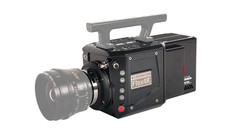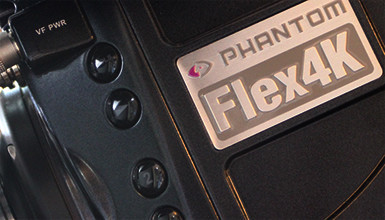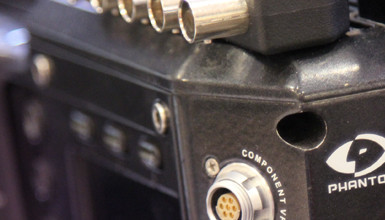Phantom® High-Speed Camera Is First Digital Cinema Camera Recognized by Academy of Motion Picture Arts and Sciences
WAYNE, N.J., January 6, 2012 -- The Academy of Motion Picture Arts and Sciences® has selected four colleagues from Vision Research, a leading manufacturer of digital high-speed imaging systems, to receive Scientific and Engineering Academy Awards® for their contributions to the design and development of Phantom® high-speed digital cameras.
The four Vision Research employees selected to receive the awards are:
- Radu Corlan, Chief Scientist, who was responsible for the sensor specification and design, camera architecture, firmware, CineMag® and CineStation® mass storage devices.
- Petru Pop, Software Architect, who was responsible for software design and tools to realize the image processing pipeline as well as the CineMag and CineStation mass storage devices.
- Andy Jantzen, Chief Technology Officer, who contributed to the sensor specification, camera and workflow requirements, and system integration.
- Richard Toftness, Vice President, Research and Development, who was responsible for the system product realization, production and engineering support, and product fine tuning.
Scientific and Engineering Awards are given for achievements that exhibit a high level of engineering and are important to the progress of the motion picture industry. "Vision Research considers it a significant honor to be recognized by its peers in the motion industry for the role its high-speed Phantom cameras have made to modern film making," comments Rick Robinson, Vice President for Marketing for Vision Research. "The Phantom camera is the first high-speed digital camera to ever receive an award from the Academy." Phantom cameras make high-speed imaging a practical reality, opening the door for all kinds of experimentation and effects at greater than 150 frames per second (fps). They were the first digital high-speed cameras designed for motion picture production and have been broadly used by film makers since 2007. Phantom cameras designed for motion picture production, including the Phantom HD, Phantom HD GOLD, Phantom 65 and Phantom Flex, acquire HD, 2K or 4K images at high speeds that, when viewed at normal projection speeds, provide super slow-motion playback.
Slow Motion and Storytelling
Slow motion replay is a key storytelling tool that allows a director to control time and to capture images that can evoke a visceral, emotional response from an audience; or show phenomena not normally seen by the naked eye. Phantom cameras enable the broader use of slow-motion photography for motion picture productions of all sizes and budgets, and their broad adoption by the motion picture industry has significantly changed the way directors and cinematographers approach film making and storytelling.
Prior to the development of the Phantom camera, shooting high-speed film at greater than 150 fps was an expensive and technically difficult proposition. A large, noisy and expensive specialty camera that consumed a 1000-foot roll of film in less than 15 seconds was required (a rotating prism camera). Results could not be seen for a day or more, and the number of scenes often was limited by budget. Since the introduction of high-speed digital imaging, a director can now shoot until satisfied and does not need to make technical or budgetary compromises.
The contributions of Phantom cameras go well beyond just creating slow-motion images. They include technologies needed to enable a practical, cost-effective workflow that can manage the huge amounts of image data associated with high-speed imaging. Each camera acquires uncompressed raw digital images at high speed into camera memory.
Since each camera has a built-in video system, these images can be viewed instantaneously. The motion picture director can immediately see the results of the previous take and make creative decisions on set. This enables creativity and experimentation at little to no additional cost to the production. Also, since the memory capacity of Phantom cameras exceeds the capacity of a roll of film (as measured by the total number of frames that can be captured at any given speed uninterrupted), longer record times are available.
Coupled with flexible triggering technologies that permit a trigger to be placed anywhere in the recording, directors and camera operators now have more flexibility and are more likely to get the desired action on each and every take. Uncompressed raw versions of selected takes can be saved immediately to the Phantom CineMag non-volatile mass storage magazines mounted to the camera for later retrieval, where they can be viewed, trimmed, played to video, or saved in a variety of formats including Vision Research's Raw Cine, DPX, Cinema DNG, etc.
Phantom cameras have been widely adopted around the world and used on dozens of motion picture productions. Among the recent films that have used Phantom cameras include: Sherlock Holmes (1 & 2), Born to be Wild 3D, Inception, Resident Evil Afterlife, Green Hornet, Secretariat, Zombieland, Source Code, Captain America: The First Avenger, TRON: Legacy, and many, many more.
The awards will be presented at the 84th Annual Academy Awards Scientific and Technical Awards ceremony on February 11 in Beverly Hills, Calif.
About Vision Research
Vision Research designs and manufactures high-speed digital imaging systems used in applications including defense, automotive, engineering, science, medical research, industrial manufacturing and packaging, sports and entertainment, and digital cinematography for television and movie production.
The Wayne, N.J.-based company prides itself on the sensitivity, high-resolution and image quality produced by its systems, robust software interfaces, and reliability and versatility of its camera family -- all which continue to stand as benchmarks for the high-speed digital imaging industry.
Vision Research digital high-speed cameras add a new dimension to the sense of sight, allowing the user to see details of an event when it's too fast to see, and too important not toTM. For additional information regarding Vision Research, please visit www.visionresearch.com.
Vision Research is a business unit of the Materials Analysis Division of AMETEK Inc., a leading global manufacturer of electronic instruments and electromechanical














